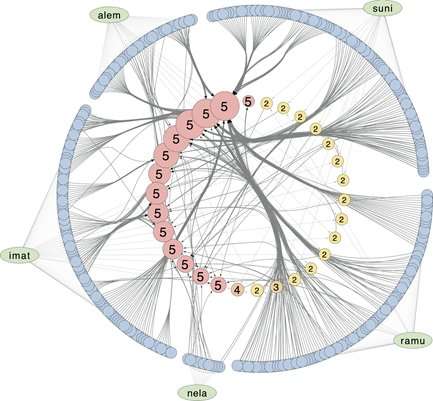The above image, Fig. 2 from the paper, was generated using Cytoscape, an Open Source tool funded by the US National Institute of Health (NIH). Credit: Elsevier
Basic research can lead to cures, drugs and other scientific breakthroughs through collaboration, confirms a new study in Heliyon (www.heliyon.com/). Understanding the extent of the collaboration that leads to breakthroughs could help research institutions plan and evaluate their own collaborative efforts.
The authors of the new study, from NET ESOLUTIONS Corporation (NETE), Gladstone Institutes, UCSF, and Elsevier, combined data mining with old-fashioned detective techniques to understand what led to the development of five major anti-cancer drugs. Their results reveal how research collaboration, grants and publications combined to make the drugs possible.
"I think our work serves as a reminder that basic science preceded and influenced these translational breakthroughs through collaboration," said corresponding author Dr. George Chacko of NETE. "Public funding of basic research has many translational benefits; the inherently collaborative nature of scientific discovery leads to breakthroughs."
In the study, the researchers used anti-cancer drugs as case studies for their methodology. They data mined public and commercial data sources, including: clinical trials; Food and Drug Administration (FDA) documents; patent applications; grant applications; and peer-reviewed papers on Scopus (www.scopus.com/home.uri) and PubMed.
To map the history of the development of five drugs - Imatinib, Sunitinib, Nelarabine, Ramucirumab and Alemtuzumab (Campath) - the team identified more than 235 researchers in five large networks, who collectively produced 106,000 peer-reviewed papers. They analyzed citations to identify a core set of publications that were cited in all the networks, including 14 publications that were common to all five networks.
"We were surprised (and delighted) by the small number of cited publications that were common to the collaboration networks, and surprised to discover how influential they were in shaping future thought," commented Dr. Chacko..
The researchers say their new approach can be easily modified and extended to other areas. It can be used to document the very large scientific collaborations that occur over many years and span basic to translational research, revealing how collaboration results in discovery and innovation that benefits the public.
However, the authors add two notes of caution. Bibliometrics, central to the study, has limitations because of varying citation practices across disciplines as well as data quality. Secondly, the team wasn't able to get access to complete funding and peer review records.
"For us, this paper is a step towards the larger goal of being able to document inputs in science and map them to outputs and outcomes. Studies like this enable greater accessibility and transparency and facilitate large-scale work. Digital methods will continue to enable greater transparency and better evaluation science," said Dr. Chacko.
The study is itself the result of a successful cross-institutional collaboration - one that took the team a year to build.
"We are lucky to have such good collaborators," Dr. Chacko added. "The NETE component of this collaboration was an unfunded thought experiment that was conducted off-hours - in the evenings, nights and at weekends. We now have some funding to extend this work, which is very helpful and I'm grateful to NETE for supporting these ideas."
More information: Samet Keserci et al. Research Synergy and Drug Development: Bright Stars in Neighboring Constellations, Heliyon (2017). DOI: 10.1101/149559
Provided by Elsevier






















